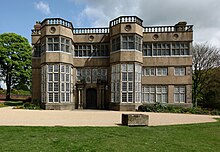Long gallery
**Examples of Long Galleries in the UK:**
– Althorp, Northamptonshire
– Apethorpe Hall, Northamptonshire
– Aston Hall, Birmingham
– Astley Hall, Chorley
– Blickling Hall, Norfolk
**Characteristics of Long Galleries:**
– Long, narrow room with a high ceiling
– Popular in Elizabethan and Jacobean houses in Britain
– Typically located on the highest reception floor of English country houses
– Often used for entertaining guests and displaying art collections
– Designed as a room for various purposes, not just as a corridor
**Evolution of Long Galleries:**
– Revivalist spirit in buildings like Harlaxton Manor
– Used to house large art collections, like at Buckingham Palace
– Early examples lacked the concept of a corridor
– Adapted over time for different functions and architectural styles
– Varied in design and purpose based on historical context
**Significance of Long Galleries:**
– Provided a space for exercise during inclement weather
– Displayed portraits of the family and royalty
– Acted as a corridor connecting different rooms
– Served as a room for entertainment and social gatherings
– Reflected the architectural trends and social norms of the time
**Further Reading on Long Galleries:**
– “The Long Gallery: Its Origins, Development, Use and Decoration” by Rosalys Coope
– Available resources in architectural history for in-depth study
– Historical references in encyclopedias and academic literature
– Explore the development and decoration of long galleries
– Understand the cultural and architectural significance of long galleries
In architecture, a long gallery is a long, narrow room, often with a high ceiling. In Britain, long galleries were popular in Elizabethan and Jacobean houses. They were normally placed on the highest reception floor of English country houses, usually running along a side of the house, with windows on one side and at the ends giving views, and doors to other rooms on the other. They served several purposes: they were used for entertaining guests, for taking exercise in the form of walking when the weather was inclement, for displaying art collections, especially portraits of the family and royalty, and acting as a corridor.



A long gallery has the appearance of a spacious corridor, but it was designed as a room to be used in its own right, not just as a means of passing from one room to another, though many served as this too. In the 16th century, the seemingly obvious concept of the corridor had not been introduced to British domestic architecture; rooms were entered from outside or by passing from one room to another.

Later, long galleries were built, sometimes in a revivalist spirit, as at Harlaxton Manor, an extravagant early-Victorian house in Jacobean style, and sometimes to house a large art collection, as at Buckingham Palace, which has a long interior space lit from above, called the Picture Gallery.
